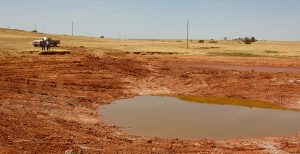
A small Oklahoma lake is shown evaporating to almost nothing in this 2011 file photo. A new NOAA-funded analysis ranked Oklahoma as the state most vulnerable to drought in the continental United States. Al Jazeera English/Flickr
California is one of the least vulnerable states to drought even as it faces record wildfires, according to a first-ever state ranking funded by NOAA.
The “Drought Vulnerability Index” finds that Oklahoma is the most susceptible to extreme dryness followed by two other states — Montana and Iowa — with a “very high” drought vulnerability.
Delaware is the least vulnerable, followed by three other states — California, Connecticut and Massachusetts — with a “very low” drought susceptibility.
The index rates each state on its exposure to drought conditions, sensitivity to the effects of drought and capacity to adapt to drought.
In an effort to provide the first state-by-state assessment of drought vulnerability, the index examines the frequency and intensity of drought in each state. It also looks at factors such as the amount of agriculture and hydropower in each state and their efforts to adapt through planning and irrigation.
“Vulnerability is not linked to physical water scarcity alone,” the researchers who created the index wrote. Instead, vulnerability is a state’s “susceptibility to harm and ability to cope with hazards.”
The index, created by University of Alabama researchers, was funded by NOAA’s Climate Program Office and the National Science Foundation and was published in a recent special issue of the journal Water focused on global drought.
The findings, which are at times surprising, “indicate the importance of the adaptation (or lack thereof) of the local economy to the climate in order to reduce sensitivity,” wrote the research team led by Hamid Moradkhani, director of the University of Alabama’s Center for Complex Hydrosystems Research.
The study urges policymakers to avoid focusing just on the amount of drought in each state and to “find the source of their vulnerability and work on improving those areas.”
The index can guide planners “on how to effectively distribute funds in order to reduce state drought vulnerability today and in the future,” Moradkhani said in an email to E&E News.
The index makes no mention of wildfire, which helps explain California’s strong rating as the state has faced record blazes in part due to drought that has parched forests and grasslands, making them easily ignited by lightning, people and downed electrical wires. Wildfire has burned 3.6 million acres in California this year — nearly double the previous record, set in 2018 — while killing 26 people and destroying 7,100 buildings, according to state figures.
California has seen wildfire increase from burning a total of 4.2 million acres in the 1990s to 7.2 million acres in the 2000s to 7.7 million acres in the 2010s, state figures show.
The 2018 National Climate Assessment reported that wildfire conditions in 2015 — when a record 10.1 million acres was burned nationwide — “were exacerbated by the preceding drought conditions in several states.”
The assessment said drought is intensifying in the U.S. as climate change raises air and water temperatures, which depletes groundwater. Increasing drought will “threaten rural livelihoods” by reducing crop yields and threatening livestock, and will also endanger oil and gas drilling and refining, the assessment found.
Moradkhani said in his email that wildfire is a “hazard that sometimes emerges as a consequence of drought,” similar to heat waves and dust storms.
California has a low drought vulnerability because of its “very advanced set of adaptive capabilities to handle droughts,” which provide a more comprehensive response than most other states, Moradkhani said.
The Drought Vulnerability Index rated each state on 11 factors including demographic characteristics such as population and per-capita wealth and drought experience from 2000 to 2019. States were rated on their vulnerability using factors such as the number of cattle; the amount of hydropower production; and the extent of water-related recreation such as fishing, swimming and boating.
States also were rated on their “adaptive capacity” — the ability “to adapt to and recover from drought” — as measured by policies such as irrigation and whether a state has a drought plan.
Oklahoma, which suffered through the notorious drought-driven Dust Bowl of the 1930s, was rated as the most vulnerable state because of its large concentration of cattle and failure to adapt to drought.
The study cited Oklahoma’s “limited adaptive capacity, including an outdated drought plan and limited irrigation possibilities, despite significant agricultural activities, including extensive cattle ranching.”
Montana is the second most vulnerable state because of “a limited adaptive capacity and an above-average sensitivity originating from limited renewable water resources, extensive farming, and a significant amount of electricity being produced by hydropower,” the researchers wrote.
In sharp contrast was Nevada, which has a “medium” drought vulnerability despite experiencing extensive drought in the parched Southwest. The study said the state has adapted by minimizing its dependence on “limited water resources” and has minimal agriculture, hydropower and recreational lakes.
States east of the Mississippi River were generally far less vulnerable to drought, largely due to a humid climate that creates “ample water resources” and lack of extensive farming. The two exceptions are New Jersey, which has high drought vulnerability because of its population density, and New York, which has extensive protected aquatic ecosystems.